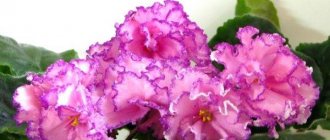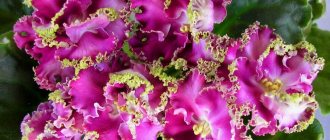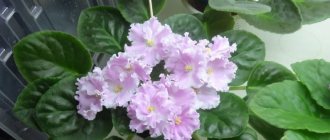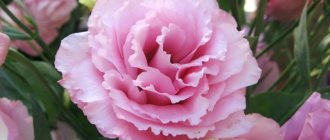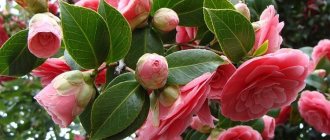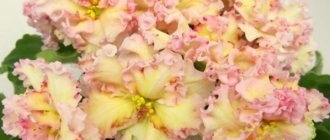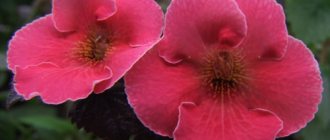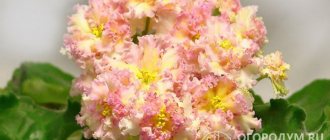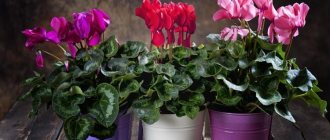After its discovery and first appearances at world flower exhibitions, the Uzambara violet especially quickly became popular among flower growers in the New World.
American lovers of indoor plants appreciated the original appearance of Saintpaulia.
They were also impressed by its ability to adapt to the proposed growing conditions in home collections, its relatively light nature and long flowering with a huge number of developing buds.
Many societies of violet connoisseurs have appeared in the country, as well as schools for breeding these exotic beauties.
Private breeders also worked to improve the decorative and varietal qualities of Saintpaulias. One of the most popular breeding group of varieties among flower growers in the world with the branded prefix “Buckeye” was created by an American master.
These violets are characterized by a magnificent exhibition appearance and do not cause any particular inconvenience when kept indoors - they are suitable for the classic care regimens for variegated varieties.
LE-Fuchsia Ballerina
Discussion of Saintpaulia varieties by breeder Elena Lebetskaya.
Moderator: Floriana
Alla Matyusheva Messages: 1296 Registered: Aug 15, 2009, 12:59 pm Awards: 14 From: Russia, Syktyvkar
LE-Fuchsia Ballerina
#1
Message by Alla Matyusheva » November 28, 2011, 16:27
Saintpaulia LE-Fuchsia Ballerina. Breeder E. Lebetskaya Large semi-double and double stars of bright raspberry-fuchsia color, light foliage.
Very abundant flowering. 2010
First flowering.
Alla Matyusheva
Fialochka_23 Messages: 168 Registered: November 01, 2011, 17:50 Awards: 3 From: Odessa region, Yuzhny
Violet_23
Blueberry Messages: 1658 Registered: March 17, 2010, 00:31 Awards: 26 From: Moscow
Blueberry
Yalo Messages: 1622 Registered: 11 Feb 2011, 16:01 Awards: 12 From: Russia. Moscow
Re: LE-Fuchsia Ballerina
#5
Post by Yalo » 13 Feb 2012, 10:03
Hard worker variety. Easy to grow, it quickly gains leaf mass and tries to bloom at every opportunity.
Yalo
FGP Messages: 229 Registered: Oct 22, 2012, 10:00 AM Awards: 9 From: Ekaterinburg
Re: LE-Fuchsia Ballerina
#9
FGP message » 29 Oct 2012, 21:42
I love her for her rare hard work and desire to bloom in any conditions, for the caps and skullcaps of flowers, for the brightness of the fuchsia color. In a word, darling.
FGP
Floriana Deputy Administrator Messages: 14940 Registered: March 20, 2011, 15:36 Awards: 48 From: Ukraine
Floriana
MIKHAILOVNA Messages: 45 Registered: June 08, 2022, 05:44 Awards: 3 From: NOVOKUZNETSK
MIKHAILOVNA
Blue, blue and lilac indoor violets
Saintpaulia, or Usambara violet Apache Magic (J. Munk)
The flowers are very large, semi-double, rich dark purple-blue, with a strongly wavy edge. The foliage is variegated and ruffled: dark green with white and pink edges. Standard.
Saintpaulia Apache Magic (J. Munk)
Saintpaulia, or Usambara violet Rainbow's Quiet Riot (R. Wasmund)
The flowers are semi-double, blue with bright white streaks. The rosette is smooth with dark green leaves.
Saintpaulia Rainbow's Quiet Riot
Saintpaulia, or Usambara violet Charming eyes
The flowers are simple, white and blue. The leaves are variegated; with age, signs of variegation disappear. Standard.
Saintpaulia Charming eyes
Saintpaulia, or Uzambara violet LE-Moon Dreams (E. Lebetskaya)
Very large blue flowers with a wavy, corrugated edge and a thin white border.
Saintpaulia LE-Moon Dreams
Saintpaulia, or Uzambara violet variety Blue Fog (Blue Fog, K. Morev)
The flowers are very large, double, blue with light wavy edges. The leaves are light green, serrated. Standard. The socket is large.
Saintpaulia variety Blue Fog or Blue Fog
Saintpaulia, or Uzambara violet LE-Sea of Happiness (E. Lebetskaya)
The flowers are simple or semi-double, white-blue with a wavy edge. Standard.
Saintpaulia LE-Sea of Happiness
Saintpaulia, or Usambara violet Storm's Eye (LLG/P.Sorano)
Saintpaulia Eye of the Storm blooms with semi-double and double large flowers. Standard. The socket is quite large.
Saintpaulia Storm's Eye
Saintpaulia, or Usambara violet variety Bold Party Girl (sport)
The flowers are double, lilac-pink with a lilac eye and light pink edges.
Saintpaulia variety Bold Party Girl (sport)
Violet Buckeye Ballerina (P. Hancock)
Author of the variety
The fancy violet "Buckeye Ballerina" was obtained as a result of scientific developments by master breeder Pat Hancock from Middletown, Ohio, USA.
IMPORTANT! The line of varieties bred by the breeder, with rare exceptions, includes Saintpaulias with variegated rosettes. Pat pays special attention to the configuration of the contours of the bush: violets with absolutely aligned rosette shapes are her trademark.
The variety first appeared at exhibitions in 1998.
Violet is quite rare in the collections of flower growers due to the frequent formation of sports.
Taxonomy
Saintpaulia "Buckeye Ballerina" in the taxonomic classification is included in the genus Saintpaulia of the Gesneriaceae family.
The size of the leaf rosette is slightly higher than the average size indicates that the variety belongs to the standard type , the fullness of the corolla refers to the terry type , and the color of the leaf blades refers to the variegated variety.
Description of appearance
The violet independently forms an exhibition leaf rosette with a symmetrical configuration of contours , an original graphic design and a mosaic arrangement of tiers. The average dimensions of the bush confirm the characteristics of the variety according to the standard type.
The leaf blades have an oval-heart-shaped shape, a quilted surface structure with glossy reflections, a finely notched edge and a faintly pronounced light venation pattern.
The leaves are painted with the color of summer greens, edged with yellowish-beige strokes and spots. Below you can see a photo of Bakai Ballerina violets.
blooms according to the bouquet type with the formation of a large number of large corollas of terry fullness, painted in shades of pinkish-lavender with abundant dark lilac fantasies throughout the entire volume of the flower.
The petals are distinguished by wavy fringed edges, set off by a thin outline of the dark lilac color, periodically interrupted and reappearing.
Sports
A significant drawback of “Buckeye Ballerina” is the frequent appearance of sports plants during propagation by leaf cuttings , which differ from varietal specimens in the absence of fancy patterns on the corollas and a change in their color:
- in purple colors of different tones;
- in pink tones;
- in purple tones.
The sport violet Buckeye Ballerina may differ from the variety solely in the color of the flowers.
Violet RS-Ballerina
Huge (up to 7cm) double wavy snow-white flowers with a finely corrugated greenish edge. Strong peduncles, abundant flowering, medium green arched foliage.
Read more
Orders are now accepted
See similar products that you can order right now
RUR 695.
74 orders
Pot size in inches: 2.5″ See additional photo for photo of supplied plantPlants do not arrive flowering...
914 rub.
56 orders
Pot size in inches: 2.5″ See additional photo for photo of supplied plantPlants do not arrive flowering...
1132 rub.
30 orders
Pot size in inches: 1.7″ See additional photo for photo of supplied plantPlants do not arrive flowering...
1132 rub.
23 orders
I RECOMMEND! THIS PHALAENOPSIS IS A NATURAL HYBRID OF 2 NATURAL ORCHIDS APHRODITE AND EQUESTRIX. GORGEOUS...
695 rub.
31 orders
Pot size in inches: 2.5″ See additional photo for photo of supplied plantPlants arrive not flowering
695 rub.
29 orders
This variety tends to bloom differently; one variety can have different flowers. Pot size...
914 rub.
20 orders
Pot size in inches: 2.5″ See additional photo for photo of supplied plantPlants do not arrive flowering...
695 rub.
23 orders
Pot size in inches: 2.5″ See additional photo for photo of supplied plantPlants do not arrive flowering...
695 rub.
24 orders
Pot size in inches: 2.5″ See additional photo for photo of supplied plantPlants do not arrive flowering...
914 rub.
22 orders
BEAUTIFUL VARIETY WITH WAVY EDGES Pot Size in inches: 2.5″Photo of plant supplied cm in to…
914 rub.
18 orders
MULTIFLOROUS LUXURY FLOWERING PHALAENOPSIS WITH DELICATE PINK FLOWERS AND A STRONG SCENT OF LILY OF THE LILY. R…
695 rub.
20 orders
Pot size in inches: 2.5″ See additional photo for photo of supplied plantPlants arrive not flowering
914 rub.
14 orders
Pot size in inches: 1.7″ See additional photo for photo of supplied plantPlants arrive not flowering
695 rub.
15 orders
Pot size in inches: 1.7″ See additional photo for photo of supplied plantPlants arrive not flowering
1132 rub.
10 orders
Pot size in inches: 2.5″ See additional photo for photo of supplied plantPlants do not arrive flowering...
914 rub.
11 orders
Pot size in inches: 2.5″ See additional photo for photo of supplied plantPlants do not arrive flowering...
1132 rub.
8 orders
Pot size in inches: 2.5″ See additional photo for photo of supplied plantPlants do not arrive flowering...
914 rub.
11 orders
Pot size in inches: 2.5″ See additional photo for photo of supplied plantPlants do not arrive flowering...
914 rub.
10 orders
Pot size in inches: 1.7″ See additional photo for photo of supplied plantPlants arrive not flowering
1132 rub.
9 orders
Pot size in inches: 2.5″ See additional photo for photo of supplied plantPlants arrive not flowering
Violet RS-Ballerina
RUB 150.80
Buyer Protection
Huge (up to 7cm) double wavy snow-white flowers with a finely corrugated greenish edge. Strong peduncles, abundant flowering, medium green arched foliage.
Botanical description of the plant
Ballerina forms a dense rosette of elastic leaves from 20 cm to 40 cm in height. The leaf blade is dark green, oval in shape, with a wavy edge. The young plant blooms about a year after planting. In spring, long flower stalks with numerous buds appear.
This variety has virtually no breaks in flowering: as soon as one peduncle fades, the next one appears in new leaves. In this case, the flowers last for about 2 months. The exception is winter, a relative period of rest. Large terry baskets up to 7 cm in diameter are painted white. The petals are arranged in several rows, the middle of the flower is yellow.
Choosing a landing site
Peony Ballerina can be bought in nurseries and garden stores. In order for the plant to take root and develop successfully, it is necessary to correctly select and prepare the planting site.
Ventilated sunny locations without strong drafts are suitable for peonies. Planting in shaded areas results in poor flowering. Avoid places near the walls of buildings, from which the plant gets overheated.
Trees that deplete moisture and nutrients should not be chosen as neighbors. Roots rot in lowlands and wetlands.
A few weeks before planting, dig a 50x70 cm hole, which is filled 2/3 with soil made from humus, earth, sand and peat. Add 0.4 kg of bone meal and 1 cup of superphosphate to the mixture.
How to grow?
Light and location
The variety "RS-Ballerina" feels great on the windowsill. This is the standard arrangement for indoor flowers. It is best to move the pot closer to the window so that the plant receives maximum sunlight. If you decide to place the container on a rack, place it in the first row. Be careful when placing the potted plant in a south-facing window. Make sure that direct rays do not touch it. If necessary, darken this area using curtains or white paper.
Important! The minimum daylight hours for the Ballerina violet should be at least 10 hours. During the cold season, it must be maintained with artificial lighting.
Humidity and temperature
The ideal temperature ranges from 20 to 22 degrees Celsius above zero. With sunset, this indicator can be lowered by 2-3 degrees. To prevent the plant from getting sick and to enjoy its rich color, protect it from sudden temperature changes and drafts. The optimal indoor air humidity varies from 50 to 60%. This value is difficult to maintain during the heating season, when batteries and heaters cause the air to become drier. To maintain comfortable conditions, place a small tray with moss or moistened expanded clay next to the plant.
Peculiarities
Officially, the “Ballerina” variety is a Saintpaulia and has all the characteristic features inherent in representatives of the flora of this category. Saintpaulia is part of the Gesneriaceae family, representing herbaceous plants with beautiful and lush flowers. Violet is the second name for plants belonging to this genus. The “RS-Ballerina” variety appeared thanks to the efforts of breeder Svetlana Repkina.
The amazingly beautiful flower immediately attracted the attention of both professional and novice flower growers. The plant began to often appear at thematic exhibitions and receive well-deserved awards due to its high aesthetic qualities.
Important! There is a variety called “LE-Ballerina” (the second name is “Fuchsia Ballerina”). This type of plant is often confused with the “RS-Ballerina” violet, but these are different representatives of the flora. Instead of a pure white color, 'Fuchsia Ballerina' blooms with bright purple buds, with a white edge around the edge of each petal.
It is worth paying attention to the description of the “Ballerina” variety. The plant got its name due to its snow-white and lush color, reminiscent of a ballerina’s tutu. Voluminous buds with double petals almost completely cover the bush during the flowering period. The size of one basket reaches 7 centimeters. Due to the arrangement of petals in several rows, the flowers are voluminous and expressive. Like other representatives of this genus, the core is bright yellow.
With proper care and comfortable conditions, you will notice that the violet almost never stops flowering (breaks are rare and very short-lived). After the old flowers wither, young flower stalks begin to form on the bush. On a healthy plant, the snow-white terry decoration lasts for about 2 months. The only time when violets will not bloom so profusely is winter. At this time of year, all plant processes slow down significantly. The first flowers begin to appear approximately 1 year after planting.
All plants belonging to the Saintpaulia genus have almost identical leaves. They are painted in a rich, dark green color, and are also covered with numerous small and soft fibers. During the development process, the plant forms a neat rosette around itself, the height of which varies from 20 to 40 centimeters. The oval shape of each leaf is complemented by wavy edges.
DIY ballerina template for a panel
In order to create a panel, you must first select a template. You can make it yourself, which is justified exclusively for people with excellent artistic skills. For everyone else, it is advisable to use a ready-made product, which will not be difficult to find.
As a rule, wall panels are made on a plain background, for which it is better to choose pastel colors. The silhouette of the ballerina itself should be either black or white. Then the picture looks most impressive.
To achieve a more festive look, you can use sparkles that adorn the dancer’s figure. Thus, you can get: a bright and memorable original panel that will never get boring over time.
In order not to make a mistake with proportions and choose the best composition, you can take advantage of master classes in which experienced craftsmen give advice to beginners. When doing the job for the first time, you can take into account their tips that will help you avoid common mistakes. Then, performing the work subsequent times, you can give free rein to your imagination, which allows you to somewhat refresh the picture and give it a touch of individuality.
Basic rules for caring for fuchsia during the growing season
The main measures for caring for fuchsia, after its acquisition, are considered:
- correct choice of location;
- compliance with temperature and humidity conditions;
- feeding
In the life of fuchsia, two periods :
- active growth: from spring to autumn;
- relative rest: winter.
Let's consider the rules for caring for a fuchsia flower during the period of active growth . At this time, the plant should be placed on a well-lit windowsill of an eastern or western window, but not in direct sunlight. It is better not to put fuchsia on southern windows, because... she is too likely to get sunburned.
If there is no bright place in the house for fuchsia, then it should be provided with additional artificial lighting , using, for example, fluorescent lamps. Otherwise, fuchsia blooms may not be seen.
This also applies when installing a flower on a northern windowsill with insufficient light.
The plant loves clean, often ventilated air . The presence of drafts is unacceptable. Rearrangements from place to place and rotations around its axis are not desirable for fuchsia. The air temperature during this period should be approximately +20+22 degrees.
higher ambient temperatures You can place fuchsia on a balcony, loggia, or open terrace in the summer. To prevent the sensitive root system of the plant from overheating in the heat, you need to transplant it into a wide ceramic pot.
Watering fuchsia during the growing season should be moderate: the soil should not become moldy or dry out. Water for irrigation should be used that is settled, soft, and at room temperature. In the hot season, the plant needs to create an additional humid microclimate.
Early in the morning or in the evening it is good to spray fuchsia with cool water. You can place a beautiful container with water and pebbles next to the flower, which will help create the desired microclimate around the flower.
The plant needs weekly feeding with fertilizers throughout the active period. After flowering has stopped, you can take a short break from using fertilizers. In the fall, from about September-October, fertilizing the flower is gradually stopped. As fertilizers, special fertilizers for house flowers are used with a high content of phosphorus and potassium, which are so necessary for the normal functioning of the flower.
With proper care, fuchsia will delight everyone with its long and lush flowering, from May to the end of November. A prerequisite for long-term flowering of a plant is the constant removal of faded flowers .
Throughout the growing season, the plant should be constantly pinched to form the desired shape. You need to be prepared for the fact that each pinching delays flowering for almost 2 months.
At home, fuchsia should be replanted annually . It is better to carry it out in March. The scheme for this is simple: first, drainage is placed in the pot, on which the prepared earthen mixture is placed, the plant with the earthen lump is carefully transferred and sprinkled with earth.
Fragrant viola or fragrant violet (Viola odorata)
Viola fragrant is a perennial plant whose flowers have a pleasant aroma. Due to this, fragrant violet extract is used to create perfumes and cosmetic products. Viola odorata is also cultivated as an ornamental plant. However, acquired varieties, after several years of cultivation, often run wild.
The leaves of the fragrant violet are round, with a serrated edge. Flowers, up to 2 cm in diameter, are located on long thin stems. Species forms are painted in purple, blue, and white tones. Cultivars can be red, yellow, purple, pink.
The fragrant violet blooms in April and early May. A second wave of flowering is possible - at the end of summer.
The size of the fragrant viola bush is almost dwarf - up to 15 cm. But, if you plant several specimens together, you will get a wonderful lush and dense cushion. Due to its decorative properties, fragrant viola is grown in pots on balconies, flower beds, flower beds and borders, in mixborders and on alpine slides.
The following varieties of fragrant violets are very popular in culture:
- Coeur d'Alsace – pink (salmon) flowers, very fragrant;
- Alba - pure white simple flowers, with a delicate aroma;
- Ashvale Blue - large white double flowers with blue spots on the edges of the petals;
- Marie Louise - blue double flowers with a white center, very fragrant;
- Lydia Groves – single large pink flowers, sweet scent;
- La France – flowers are large, purple, simple in structure;
- Orchid Pink has simple pink-purple flowers with pale blue stripes in the center.
Bury the seeds 0.5-0.7 cm and sprinkle the furrows with soil rubbed with your fingers, water moderately and lightly the surface with sawdust (this will keep the soil moist). Literally in 5-7 days the first shoots will appear, which it is very advisable to shade (pull a dark film on top). After 2-3 weeks the film can be removed.
Seeds for seedlings are planted in a similar way indoors. Young shoots are picked twice: the first time 5-7 days after planting, the second time 2-3 weeks according to the scheme: 6x6 cm. And after 1.5-2 months the seedlings are transferred to their permanent residence in open ground. The distance between the planting holes is 20-25 cm, this is quite enough for its easy growth.
Viola tricolor (tricolor violet)
(Viola tricolor)
Species of Wittrock's viola (Viola wittrokiana)
combines multiple varieties, hybridized with the participation of Altai, yellow and tricolor violets. Strongly branched, with large (up to 10 cm in diameter) single flowers. The height of the plant ranges from 15 to 30 cm (depending on the variety). Usually cultivated as a biennial. Good for trimming low-growing shrubs.
Altai viola (Viola altaica) is an ornamental perennial up to 20 cm tall with blue-violet or white flowers with blue stripes, “illuminated” by a bright yellow spot. The spur is almost invisible. It blooms twice a season: from late April to mid-June and from August until frost. It is frost-resistant and is quite suitable for planting in gardens in central Russia.
Reproduction
There are several ways to propagate the plant at home. Let's look at the most common options.
Cuttings
To propagate using this method, a leaf is separated from the plant. He must be strong and healthy. It is best to choose a cutting from the middle row of the bush rosette. The following sequence should be followed:
- the leaf is carefully cut at an acute angle of 40–45 degrees;
- it is placed in a small container, where clean water and an activated carbon tablet are added;
- by covering the leaf with a cut plastic bottle, you can create a greenhouse effect that will promote growth;
- When roots appear, the sprout can be transplanted into the ground.
Children
You can grow violets from children if you use a rooted leaf. The work is carried out as follows:
- the bush is taken out of the pot;
- the baby is carefully separated from the root system of the mother plant; it must have at least 2 sheets;
- a separate sprout is transplanted into a container with soil, the height of which is no more than 6 centimeters.
Features of flowering, growth and reproduction
The life processes of the violet “Buckeye Ballerina” proceed according to the same laws as those of other varieties of the variegated group, differing only in minor nuances.
Development in indoor culture
Violet is characterized by a non-capricious character ; it does not require the creation of any special conditions of detention, except for a relatively cool room and a slight increase in air humidity, which can be achieved using simple methods.
The formation of the rosette occurs independently ; the bush always has aligned contours and a symmetrical configuration.
The leaf plates are laid in a tiled pattern, forming an exhibition bush with a mosaic pattern.
Flowering occurs over long periods of time with the formation of a significant number of large buds . Rest breaks for this variety are short in duration.
The nuances of violet development can safely include:
- strengthening of varietal characteristics (fancy coloring of corollas) from flowering to flowering;
- disappearance of fantasy at elevated temperatures;
- slightly slower rate of growth and development;
- the formation of rosettes with very dense filling, sometimes requiring thinning;
- falling of peduncles onto a leaf rosette in low light;
- produces a large number of children when propagated by leaf cuttings;
- distinguished by his very frequent involvement in sports.
Time of formation of an adult rosette
Propagation of violets is possible from a stepson separated from the mother plant and rooted, or using leaf cuttings.
The formation of Saintpaulia, already capable of flowering, from leaf cuttings will take about 8-10 months , during which the formation of children, their rooting and the growth of leaf mass will occur.
Buckeye Ballerina is considered mature at 8-10 months.
An adult specimen from the process will be able to form a little faster.
Reproduction methods and features
Florists can use only two methods to propagate Uzambara violets:
- children formed on the violet itself;
- children formed on leaf cuttings.
The seed method for propagation in indoor culture is excluded, since it does not transmit the varietal characteristics of the specimens.
ADVICE! To ensure the preservation of all varietal characteristics of violets, it is best to use the rejuvenation method.
Flowering in different temperature conditions
At lower temperatures on the blooming corollas, the fancy coloring appears with much greater intensity, and the lifespan of each flower increases slightly due to the fact that it is kept cool for its decorative appearance.
High temperatures can not only destroy fancy patterns, but also change the shape and size of the corollas, as well as shorten the flowering period or even postpone it to another period.
Appearance of peduncles
The variety forms not too long peduncles of a fairly strong structure , capable of holding about five large corollas in an erect position, forming a lush bouquet in the center of the leaf rosette.
The strength of the peduncles is strongly influenced by the illumination of the room - with a lack of light, the peduncles increase in size, become thinner and can no longer withstand the weight of the flowers, falling onto the leaves of the rosette.
Flowering type
very neat bouquets from large buds on strong peduncles . Terry fullness and strong fringe of the corollas add volume and majesty to flower bouquets.
Bud lifespan
Violet is capable of blooming for periods of one to three months while maintaining freshness and chic decorativeness throughout the entire time. Each individual bud is able to remain decorative for approximately one to one and a half months.
Advice! Keeping the flowering specimen in a cool room can help extend this period.
Reviews
- Tula region: winters and blooms normally, flowers look like clematis “Miss Bateman”;
- Kaluga region: it blooms very beautifully; in warm winters, meter-long lashes are preserved without shelter;
- Minsk region, Belarus: clematis took a long time to grow, began to bloom normally only in the fifth year;
- Leningrad region: it is not always possible to preserve last year’s stems, and “Ballerina” blooms very late on new ones;
- Vitebsk region, Belarus: the plant died;
- Moscow region: grows well, blooms every year, covers itself in the simplest way.
If you also grew or are growing clematis "Balerina", please leave your feedback in the comments to the article.
Possible diseases and pests
To prevent the plant from dying from disease or attacks from dangerous insects, preventive measures are needed. Before transplanting, it is recommended to heat the earthen mixture in an oven or treat it with a light solution of manganese. You also need to carefully examine the plant for symptoms and use medicinal drugs at the first signal.
It is worth paying attention to the most common problems.
Root rot
This disease affects the root system of the plant. The violet begins to lose its bright color and elasticity. The leaves gradually turn yellow and fall off. In this case, you need to remove the flower and inspect the roots. To cope with the problem, the flower is sprayed with a solution of “Fitosporin-M” (consistency – 1.5 grams per 1 liter of water). After treatment, the violet is transplanted into a clean pot with updated soil.
Shchitovka
This is a dangerous pest, which can be identified by the presence of a gray-brown shield on its back. If it is detected, move the violet to another place and treat it with the appropriate composition. The drug "Topsin-M" is excellent.
Thrips and aphids
These small sucking insects destroy the flower by feeding on its sap. To save the violet, use the Agravertin composition according to the instructions for use.
Gray rot
With this disease, the leaves become covered with a gray and fluffy coating. This disease can be overcome with the help of Topsin-M.
For a review of the “Ballerina” violet variety, see the following video.
How to care at home
Its development and the duration of flowering of the bush depend on the quality care of Saintpaulia.
Watering
To water the flower, use water that has been standing for at least a day at a temperature of +20°C. Since the bush forms a dense rosette, overhead watering will be inconvenient. In this case, it is better to use watering through a tray. Water is poured in small portions, then left for 10–15 minutes, the remaining water is drained. The frequency of watering will depend on the degree of drying of the top layer of soil 1.5 cm.
Fertilizer application
Long-blooming violets need to constantly replenish their supply of nutrients, so the plants are fed 2 times a month. Balanced mineral complexes are used, for example “Bona Forte for violets and begonias”. According to the instructions, for root feeding you need to dilute 10 ml/1.5 l of water. Experienced flower growers recommend halving the dosage from the manufacturer.
Transfer
Every spring, the bush requires soil renewal. The plant is removed from the old container by tapping the edges. Gently shake off the adhering soil; if there are traces of oxidation, it is better to rinse the roots with water and dry them before replanting. Roots that are too long or diseased, damaged roots are trimmed, and the sections are sprinkled with crushed activated carbon.
The surface root system of the plant does not tend to grow much in volume or depth: as the bush grows, old roots die off, and new ones form above the soil surface under the lower leaves, so a new pot is needed no more than 10 cm in volume and the same in height.
To prepare the soil mixture you will need the following components:
- garden soil - 2 parts;
- perlite - 2 parts;
- river sand - 1 part;
- peat - 1 part.
Transplant technology:
- 2-3 cm of drainage (large pebbles, expanded clay) is placed in the pot.
- A bush is placed on a hill of soil with the roots spread out.
- Deepen the bush to the bottom row of leaves and water it.
- If within 2 weeks the plant throws out flower stalks, it is better to cut them off, since the root system has not yet adapted sufficiently.
